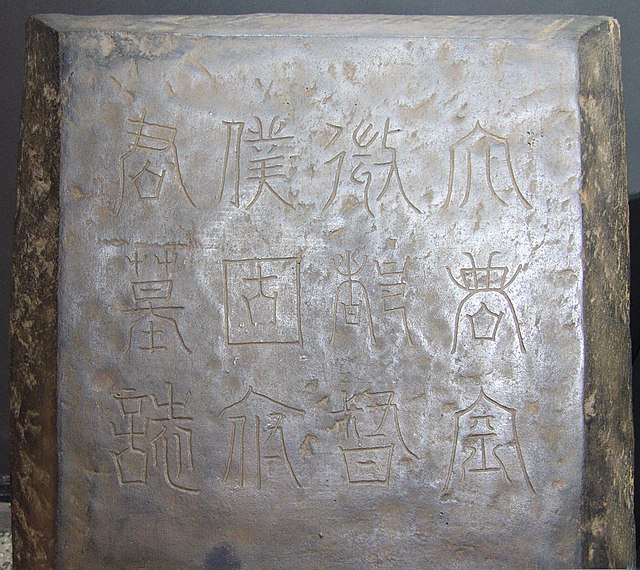The epitaph of Pugu Yitu is an inscription found inside the tomb of Pugu Yitu. It dates to 678 and was found in 2009 by a joint Russian-Mongolian team in Zaamar sum, Tov Province, 160 km west of Ulaanbaatar, Mongolia about 2.5 km north-east from the banks of the Tuul River and close to the 10th-century Khitan town of Khermen Denzh on the banks of the Tuul River. The inscription is currently displayed at the Zanabazar Fine Arts Museum in Ulaanbaatar. The tomb of Pugu Yitu, also called the Shoroon Dov Kurgan, showed signs of attempted looting in ancient times. The nearby tomb of Shoroon Bumbagar was never looted and therefore was found to hold far more artifacts including an intact door, many statues and wall paintings of people, dragons and temples, although there was no inscription. The tomb of Pugu Yitu is unusual in that it has an inscription. Apart from the cover inscription of Pugu Yitu measuring 75 cm x 75 cm with 4 lines of 3 characters each, the main inscription has 28 lines with 31 characters each. The language of the inscription is Classical Chinese and relates the biography of Pugu Yitu the Dudu (都督) or Commander-in-Chief of the Jinweizhou (金微州) protectorate under the Tang dynasty's Jimi system. A photo of the inscription can be found on the Mongol Toli website.

Image: Epitaph cover, Zanabazar Museum, Ulaanbaatar, Mongolia
Image: Epitaph of Pugu Yitu
Epitaph cover of Pugu Yitu.
Epitaph of Pugu Yitu.
The Shoroon Bumbagar tomb is an ancient tomb in Zaamar sum, Tov Province, 160 km west of Ulaanbaatar, Mongolia about 2.5 km north-east from the banks of the Tuul River and close to the 10th-century Khitan town of Khermen Denzh on the banks of the Tuul River. It was built for a Turkic nobleman between 650 and 700 CE.
Shoroon Bumbagar tomb mural, Göktürk, 7th century CE, Mongolia.
Shoroon Bumbagar tomb mural, Göktürk, 7th century CE, Mongolia.
Mural from the dromos of Shoroon Bumbagar, attendants in Chinese costume.
Mural from the dromos of Shoroon Bumbagar, attendants in Chinese costume.






